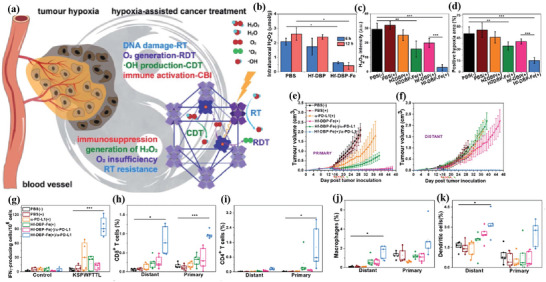Figure 5.

a) Scheme, Hf–DBP–Fe harnesses tumor hypoxia for cancer treatment via RT–RDT and CDT as well as synergistic combination with CBI. Local injection of Hf–DBP–Fe in MC38 tumors followed by low‐dose X‐ray irradiation relieves tumor hypoxia by porphyrin–Fe(III)‐mediated H2O2 decomposition to generate O2 for RDT and cOH for both CDT and RT. ICD caused by local RT–RDT and CDT synergizes with anti‐PD‐L1 CBI to lead to systemic antitumor immunity. b) H2O2 concentration of tumors treated with PBS, Hf–DBP, or Hf–DBP–Fe at an equivalent dose of 0.2 mmol per mouse 6 or 12 h after injection quantified with TiOSO4, n = 3. Quantitative analysis of c) the total fluorescence intensity of the H2O2 kit, d) the positive area of hypoxia. e) Primary and f) distant tumor growth curves of MC38 bilateral tumor‐bearing mice treated with different groups. g) Enzyme‐linked Immunospot (ELISPOT) assay for the detection of tumor‐specific IFN‐g producing T‐cells. Splenocytes were harvested 12 days after the first treatment and were cocultured with the stimulating KSPWFTTL peptide for 42 h. Percentages of tumor‐infiltrating h) CD8+ T cells, i) CD4+ T cells, j) macrophages, and k) DCs with respect to the total tumor cells, calculated by flow cytometric analysis. Reproduced with permission.[ 136 ] Copyright 2020, The Royal Society of Chemistry.
